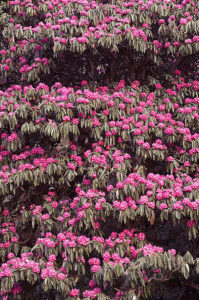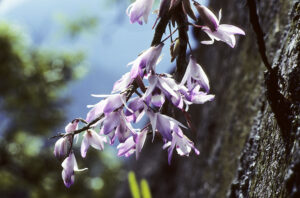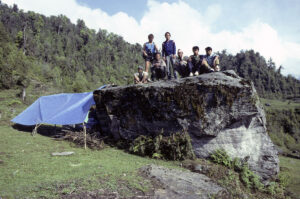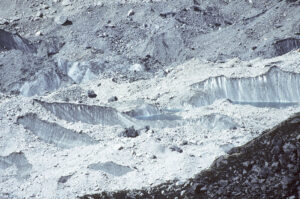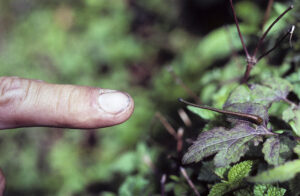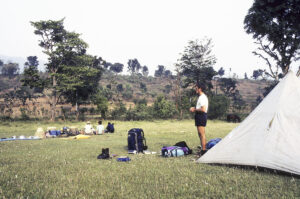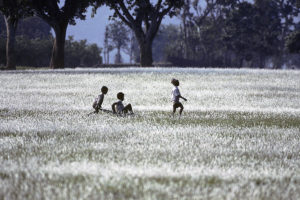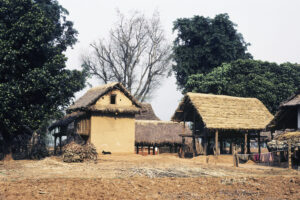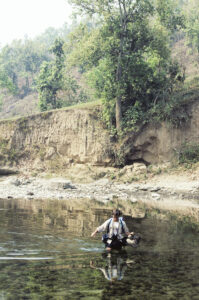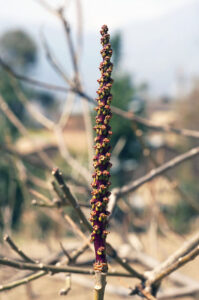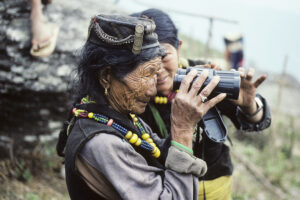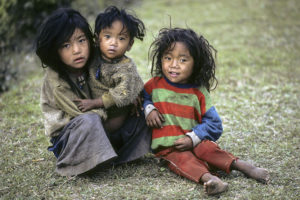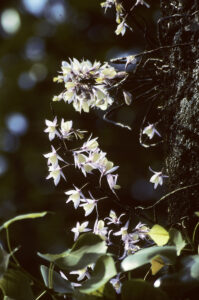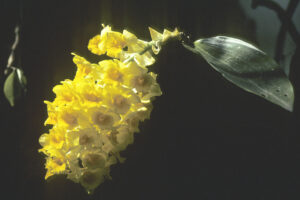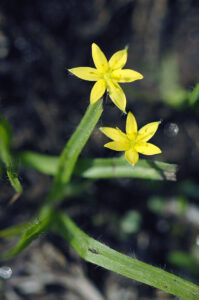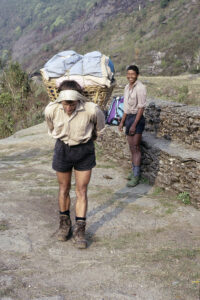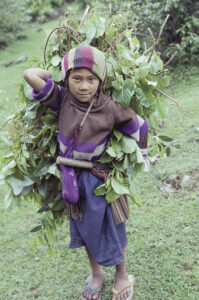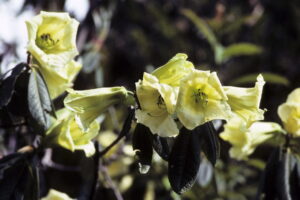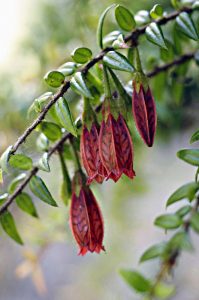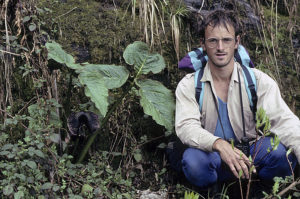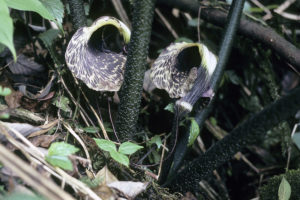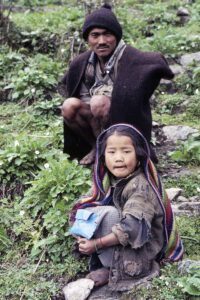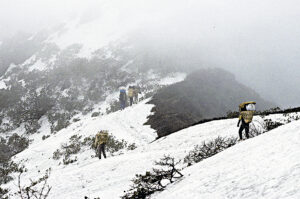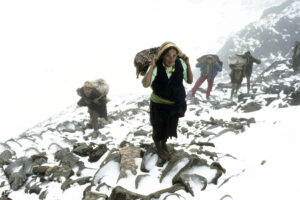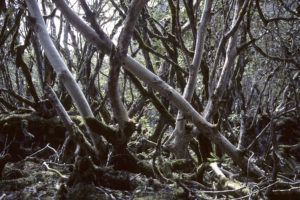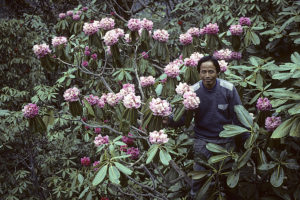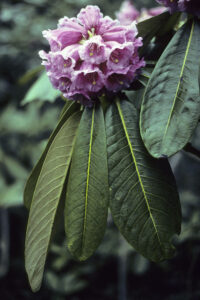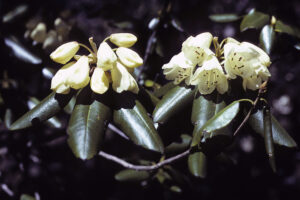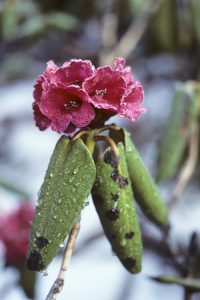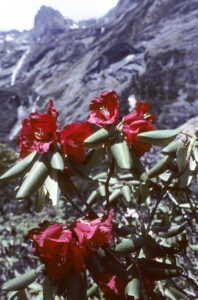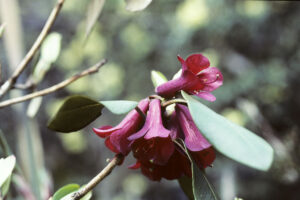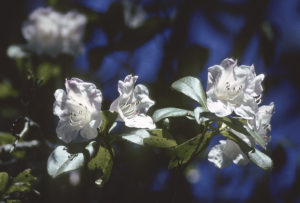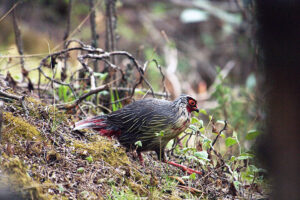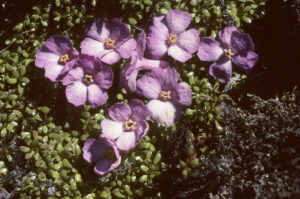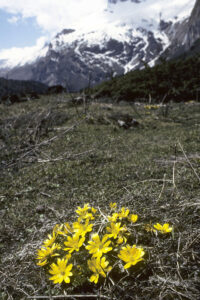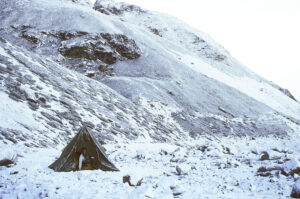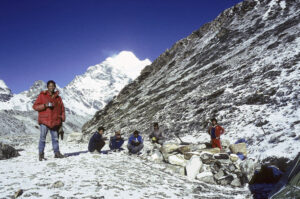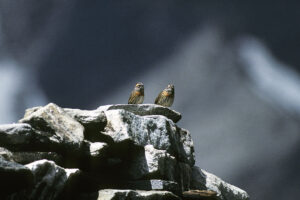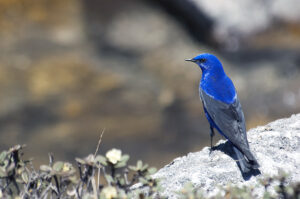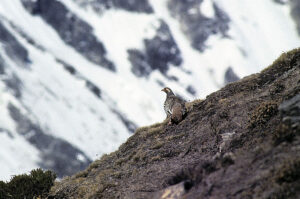The rhododendron valley
Rhododendron arboreum is very common in the Himalaya, growing between 1,500 and 3,600 m altitude. It is the national plant of Nepal, called lali guras (’red rhododendron’). (Photo copyright © by Kaj Halberg)
A gorgeous epiphytic orchid, Dendrobium nobile, Arun Valley. No less than c. 26 species of this genus are found in the Himalaya. (Photo copyright © by Kaj Halberg)
The eastern Himalaya and China are home to hundreds of rhododendron species. A tiny country like Bhutan, for instance, harbours more than 60 species. The further west you travel in the Himalaya, the fewer species you encounter. Thus, eastern Nepal is home to c. 30 species, western Nepal to 7, and Kashmir to only 4.
Most rhododendron species are shrubs or small trees, which bloom between March and July, with a peak in April-May. A majority of the species display flowers of various shades of red, yellow, or white, whereas violet or greenish is rarely seen.
In the Himalaya, rhododendron species occur in almost all vegetation zones, from subtropical to alpine, the major part growing between 2,000 and 4,000 m altitude. The largest species is Rhododendron arboreum, which can grow to 15 m tall. It is the national plant of Nepal, called lali guras. At the opposite end of the spectrum are various dwarf shrubs, including R. setosum, R. nivale, R. lepidotum, R. anthopogon, and R. pumilum, the latter only 10-15 cm high. Other species are epiphytes, including the large-flowered R. dalhousiae and R. lindleyi.
Most plant species mentioned on this page are described in detail on the pages Plants: Himalayan flora 1, 2, and 3.
My companion Lars Nørgaard Hansen (standing, in shorts) and our staff at our camp above Tashigaon. The kitchen has been arranged under the blue tarpaulin. (Photo copyright © by Kaj Halberg)
A wilderness valley
Arun is one of the major rivers of eastern Nepal. The source of one of its tributaries, the Barun River, is the glaciers at the foot of the mighty Makalu (8463 m), the fifth-highest mountain in the world, situated on the border between Nepal and Tibet. The Barun Valley is uninhabited, and very few people come here. It is one of the wildest and most remote of all alpine valleys in the Himalaya, and to preserve this unique wilderness for future generations, the valley and its surrounding mountains have been designated as a strict nature reserve, in which human exploitation is limited to an absolute minimum.
The Barun Valley constitutes a part of Makalu-Barun National Park, which was established in 1992, covering an area of c. 1,500 km2. To the west, the park borders Sagarmatha National Park, covering 1,148 km2, to the north the huge Qomolangma Nature Preserve in Tibet, covering c. 35,000 km2, and to the south a buffer zone, covering 830 km2. Thus, the valley is situated in the heart of an enormous protected area.
To hike in Makalu-Barun National Park, you must get a permit from the National Park Office in Kathmandu, which can be obtained by paying a fee. Tents, cooking equipment, and fuel must be brought along, as there are no facilities above the village of Tashigaon. Burning wood in the park is strictly prohibited. With an annual precipitation of c. 3,500 mm, the area is one of the wettest in Nepal. Even in May – well before the monsoon period – a hike in this park can become a rather wet experience, with many leeches.
This area is home to a tremendous number of plants – more than 3,000 species have been found within the park boundaries. In May, you may encounter no less than 25 blooming rhododendron species, and the park is also home to 47 orchid species, 48 primrose species, 19 bamboo species, and 15 species of the genera Quercus, Cyclobalanopsis, Castanopsis, and Lithocarpus, of the beech family (Fagaceae).
More than 400 bird species have been observed, and the park is also a refuge for several threatened mammals, such as clouded leopard (Neofelis nebulosa), red panda (Ailurus fulgens), and alpine musk deer (Moschus chrysogaster).
Upper Barun Valley is a harsh and inhospitable area. This picture shows the Lower Barun Glacier, with deposits of moraine. (Photo copyright © by Kaj Halberg)
A hike in Makalu-Barun National Park can be a rather wet experience, with many leeches. These blood-suckers sense their ‘prey’ from the carbon dioxide, emitted from the body. (Photo copyright © by Kaj Halberg)
In the tropical Arun Valley
Towards the end of April 1991, my companion Lars Nørgaard Hansen and I, together with our guide Saila Tamang, fly from Kathmandu to the small town of Tumlingtar, situated in the tropical part of the Arun Valley. Two days prior, our staff boarded a bus, bound for the town of Hille, from where they have reached Tumlingtar on foot.
Lars in our camp at the outskirts of the village of Tumlingtar. (Photo copyright © by Kaj Halberg)
In a nearby field, which was full of silver-headed grasses, these boys had fun, playing with a wheelbarrow. (Photo copyright © by Kaj Halberg)
Arundina graminifolia, Tumlingtar. This large ground-living orchid is fairly common in hotter parts of Nepal. It has a wide distribution in Tropical Asia, and further east on islands in the Pacific Ocean. (Photo copyright © by Kaj Halberg)
Hiking up the valley
The Barun Valley is indeed very remote, so in order to get there you must walk a fairly long distance. The following morning, we commence our hike, heading north along a ridge on the eastern side of the valley. Up to an altitude of c. 1,800 m, most of the forest has been cleared for farmland.
Along the trail, we often notice tiger’s milk-spruce (Falconeria insignis, formerly known as Sapium insigne), a tree of the spurge family (Euphorbiaceae), which grows to 10 m tall. Its upright inflorescences appear late in winter or early in spring, before the leaves. Later, its tiny flowers turn into remarkable chocolate-brown fruits, the size of a pea.
Here and there are small patches of subtropical forest with many species of trees, including chir pine, or long-leaved pine (Pinus roxburghii), and chestnuts of the genus Castanopsis, whose seeds are edible. Many epiphytes adorn the trees, including two species of mistletoe, Scurrula elata and Taxillus vestitus, and beautiful orchids of the genera Coelogyne and Dendrobium, the latter comprising no less than c. 26 species in the Himalaya.
Farmhouse near Tumlingtar. (Photo copyright © by Kaj Halberg)
Lars, wading across the Sabhya Khola, a tributary to the Arun River near Tumlingtar. (Photo copyright © by Kaj Halberg)
The upright inflorescences of tiger’s milk-spruce (Falconeria insignis), appear late in winter or early in spring, before the leaves. This tree grows to about 10 m tall. (Photo copyright © by Kaj Halberg)
Sherpa women, enjoying a look through my binoculars. (Photo copyright © by Kaj Halberg)
We met these children near the village of Sangrati, in the Arun Valley. It is often the duty of Himalayan girls, however young, to take care of a smaller sibling. (Photo copyright © by Kaj Halberg)
Dendrobium polyanthum, an epiphytic orchid, hanging down from a tree trunk, Arun Valley. (Photo copyright © by Kaj Halberg)
Five chestnut species of the genus Castanopsis grow in subtropical valleys of eastern Nepal. This picture shows inflorescences of C. indica. (Photo copyright © by Kaj Halberg)
Like a Turkish bath
On the forest floor, we observe bushes like Viburnum erubescens and Melastoma normale, the latter with beautiful reddish-violet flowers. Herbs include Cautleya gracilis, of the ginger family (Zingiberaceae), and the peculiar Arisaema tortuosum of the arum family (Araceae).
In a grass-covered area, we find tiny star-shaped yellow flowers of Hypoxis aurea. This small genus constitutes a separate family, Hypoxidaceae, which is closely related to the amaryllis family (Amaryllidaceae).
From the village of Num, a steep trail leads through terraced fields and lush patches of forest down to the Arun River. The altitude here is a mere 700 m, and the climate is hot and very humid – like in a Turkish bath. On the river bank, we observe yet another Dendrobium species, D. densiflorum, with a cluster of gorgeous yellow flowers.
A suspension bridge brings us to the western bank, from where we make a long, tough hike up to the village of Tashigaon – the last permanently inhabited village of the area. Along the terraced fields, we observe a number of weeds, including goat-weed (Ageratum conyzoides), a tiny St. John’s wort, Hypericum japonicum, a dayflower with blue flowers, Commelina paludosa, downy bur-marigold (Bidens pilosa) with white flowers, and an everlasting, Pseudognaphalium affine, with yellow flowers.
Dendrobium densiflorum, growing on a bank along the Arun River, at an altitude of c. 700 m. (Photo copyright © by Kaj Halberg)
In a grassy area, we found tiny star-shaped flowers of Hypoxis aurea. (Photo copyright © by Kaj Halberg)
Lars tried to carry the basket of one of the porters, laden with provisions. “Gosh, it’s heavy!” he said. The porter found the action highly amusing. (Photo copyright © by Kaj Halberg)
Temperate forest flora
Between c. 1,800 and 3,500 m altitude, a mixed temperate forest is found, harbouring species like Magnolia campbellii, an oak, Cyclobalanopsis lamellosa, a maple, Acer campbellii, Himalayan hemlock (Tsuga dumosa), and the large Rhododendron arboreum. On the forest floor, we observe shrubs like Viburnum nervosum, the beautiful Daphne bholua var. glacialis, and Deutzia bhutanensis, of the hydrangea family.
Joseph Dalton Hooker (1817-1911) was a British botanist, who, during the period 1848-1850, described no less than 22 new rhododendron species from Sikkim and other parts of the eastern Himalaya, including the gorgeous Rhododendron dalhousiae, an epiphytic species with a profusion of lemon-coloured flowers, which later turn white. This plant was named in honour of Lady Dalhousie, wife of George Ramsay, the 9th Earl of Dalhousie, who was governor-general in India in the first half of the 1800s. This lady was an avid collector of plants.
Other epiphytes include a dwarf shrub of the heath family, Agapetes serpens, whose amphora-shaped flowers are red with darker markings, and sausage vine (Stauntonia latifolia, formerly called Holboellia latifolia), which belongs to a small Oriental plant family, Lardizabalaceae. The common name alludes to its sausage-like, hanging fruits.
A mat-forming wintergreen, Gaultheria trichophylla, grows on moss-covered rocks. At this time of the year, it has small white flowers, but in autumn it is easily identified by its almost luminous, blue berries, which are edible. A picture showing these berries is found on the page Plant hunting in the Himalaya: Rainy season in Nepal.
Herbs in this zone include another Arisaema species, A. griffithii, a strange-looking plant with a very short flower-stalk and a curled-up spathe. We also observe a meadow-rue, Thalictrum virgatum, with rather large, white flowers, a pink primrose, Primula petiolaris, and Paris polyphylla, a close relative of the European Herb Paris (P. quadrifolia).
From a rocky ridge near Kauma, we can enjoy a magnificent view towards Kangchendzonga (8586 m), the third-highest mountain in the world.
This girl is carrying fodder for her family’s cattle from the forest to her home in the village of Navagaon. (Photo copyright © by Kaj Halberg)
Rhododendron dalhousiae, near Tashigaon. Initially, the flowers are pale yellow, later turning snow-white. (Photo copyright © by Kaj Halberg)
The amphora-shaped flowers of Agapetes serpens are usually red with darker markings, but it also comes in a form with white flowers. This genus has five members in the Himalaya. (Photo copyright © by Kaj Halberg)
Lars above Tashigaon, seated near a large specimen of Arisaema griffithii. (Photos copyright © by Kaj Halberg)
Sheep herders, father and daughter, above Tashigaon. (Photo copyright © by Kaj Halberg)
Across snow-covered passes
To enter the Barun Valley, we must cross two passes north-west of Kauma, Keke La and Shipton La. The maximum altitude is a mere 4,229 m, but due to the topography of this area, precipitation is very high all winter, spring, and summer. As a result, these passes are snow-covered until late June, and if you hike here without a guide, you may easily get lost.
On our way towards the Barun Valley in late April, we saw no flowering plants at all at these heights, and even on our return journey three weeks later, only three species were blooming: Bergenia purpurascens, of the saxifrage family, a violet primrose, Primula calderiana, and a rare member of the primrose family, Omphalogramma elwesiana, for which these passes constitute a core area.
Our porters struggle through snow and fog on our way towards the Shipton La Pass. (Photo copyright © by Kaj Halberg)
On our way across the passes, we met these porters, going the opposite way. Note that the woman is bare-footed. If she had been one of our porters, we would have bought her a pair of sneakers! (Photo copyright © by Kaj Halberg)
The rhododendron valley
North of the passes, the route along the Barun River leads across dramatic rock falls, covering a distance of about 2 km. New slides constantly change the ‘trail’, which is sometimes very hard to find. Furthermore, larger or smaller stones often come tumbling down towards us, so we keep a sharp look-out. We are indeed relieved, when we have passed the last of the landslides.
In the Barun Valley, the mountain slopes are covered in forest, chiefly of Himalayan silver fir (Abies spectabilis) and Himalayan birch (Betula utilis). Lower strata of the forest are often a dense tangle of large shrubs, comprising two rhododendron species, R. hodgsonii and R. campylocarpum. These thickets are a fine habitat for the rare Alpine musk deer, and also for the beautiful blood pheasant (Ithaginis cruentus), named after the tear-shaped red streaks on the breast of the cock. Pictures, depicting the musk deer, are shown on the page Animals – Mammals: Mammals in the Himalaya.
The remaining rhododendron species in the Barun Valley are smaller, including R. fulgens, R. thomsonii, R. ciliatum, R. cinnabarinum, and R. wightii. On the slopes, we observe the tiny R. pumilum, which is rather common in this valley, but is otherwise rare in Nepal.
A dense tangle of Rhododendron hodgsonii, Barun Valley. (Photo copyright © by Kaj Halberg)
Our guide Saila Tamang, standing among Rhododendron hodgsonii. This species is easily identified by its dense inflorescences and large leaves. (Photos copyright © by Kaj Halberg)
Pale-yellow, almost translucent flowers of Rhododendron campylocarpum. (Photo copyright © by Kaj Halberg)
Many rhododendron species are very hardy. This picture shows Rhododendron fulgens, covered in rime. (Photo copyright © by Kaj Halberg)
Rhododendron wightii has large white flowers with red blotches inside. In the background a black rock, named Neh. (Photo copyright © by Kaj Halberg)
Rhododendron thomsonii is easily identified by its red calyx and wax-like flowers. (Photo copyright © by Kaj Halberg)
Rhododendron cinnabarinum has oblong, usually dark red flowers. (Photo copyright © by Kaj Halberg)
The flowers of Rhododendron ciliatum are white with a pinkish tinge. (Photo copyright © by Kaj Halberg)
The beautiful blood pheasant is named after the tear-shaped red streaks on the breast of the cock. (Photo copyright © by Kaj Halberg)
May flora in the valley
In May, herbs of the valley have only just begun to bloom. The beautiful pink Diapensia himalaica grows here and there, and we also observe Adonis nepalensis, which closely resembles the European spring adonis (A. vernalis), but is smaller. Other species include a cushion-forming saxifrage, Saxifraga pulvinaria, the yellow-flowered Corydalis govaniana, and a small violet primrose, Primula atrodentata.
At Neh, an ominous black rock wall rises almost vertically from the valley floor. At this point, the valley makes a sharp, ninety-degree turn towards west. We observe lammergeiers (Gypaetus barbatus), gliding effortlessly along the rock wall, searching for bones, which they carry high up in the air, letting them fall onto the rocks, after which they eat the marrow of the splintered bones. South of the valley is a towering snow-covered mountain, Peak 7 (6185 m), from which a glacier, covered in moraine, slowly slides into the valley.
The pink Diapensia himalaica, which is rare in Nepal, grows here and there in the Barun Valley. (Photo copyright © by Kaj Halberg)
The pretty Adonis nepalensis closely resembles the European spring adonis (A. vernalis), but is smaller. (Photo copyright © by Kaj Halberg)
At the foot of Makalu
As we head westwards, most of the larger rhododendron species soon vanish, giving way to a juniper, Juniperus indica, and dwarf shrubs like Rhododendron anthopogon and a tiny willow, Salix hylematica. Rufous-breasted accentors (Prunella strophiata) are perched on rocks or juniper bushes, and Apollo butterflies (Parnassius) flutter about.
Grandalas (Grandala coelicolor) are feeding in the grass. The gorgeous males are bright blue, whereas females are brown, with faint white stripes on breast and back. This bird is presented in depth on the page Animals – Birds: Thrushes. In rocky areas, we often observe large greyish-white gamebirds, Tibetan snowcocks (Tetraogallus tibetanus). At dawn, their powerful call, gukka-gukka-guk-guk-guk-grrr, can be heard far away.
On the south-side of the valley, Peak 6 (6739 m) is towering towards the sky, whereas three other peaks, Chonku Chuli (6809 m), Baruntse (7220 m), and Peak 4 (6720 m) are situated at the end of the valley. Small avalanches of snow and rocks constantly tumble into the valley from glaciers and mountain slopes.
Further west, the juniper shrubs become stunted and wind-blown. In this harsh environment, we find very few blooming herbs, two small gentians and a violet-flowered member of the mustard family. Most of the valley floor is occupied by the huge Barun Glacier, the major part of it covered in eroded soil and rocks.
From a sandy plain, Merak, we head north, following a ridge, which ends on a tiny plateau, situated at an altitude of c. 5,300 m. From here, we have a fantastic view towards numerous towering mountains, including Makalu, Lhotse (8511 m), and Sagarmatha (8850 m).
Even in May, the climate in the Upper Barun Valley is often severe. One night we were surprised by a snow storm, but the following morning was glorious. (Photos copyright © by Kaj Halberg)
Rufous-breasted accentors, perched on a rock. (Photo copyright © by Kaj Halberg)
The male grandala is a gorgeous bird. (Photo copyright © by Kaj Halberg)
The large Tibetan snowcock is restricted to upper alpine areas of the Himalaya. It is able to run very fast and is rarely observed flying. (Photo copyright © by Kaj Halberg)
References
south-asia.com/showcase/Tour/pmakalu.html
Polunin, O. & A. Stainton 1984. Flowers of the Himalaya. Oxford University Press
Stainton, A. 1988. Flowers of the Himalaya. A Supplement. Oxford University Press
(Uploaded April 2016)
(Latest update October 2022)
